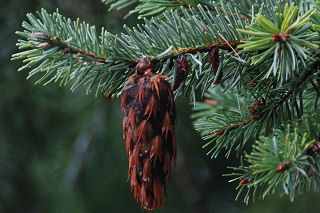
This guide will help you identify the conifers of the Pacific Northwest, native to the states of Oregon and Washington. This is a small sized version of the main Northwest Conifers Web site nwconifers.com. You can view this mobile version on your smart phone to help you identify native conifers when you are out in the woods. It is organized to help you identify conifers by presenting them by area and elevation and showing photos and simple descriptions of identifying features for each conifer native to that zone. Start by looking at the Low-elevation Conifers in northwest Oregon and western Washington. Once you are familiar with them, you can move on to conifers in other areas.
Where to find native conifers
A good place to start looking for low-elevation conifers is a nearby nature park where native conifers have been allowed to grow. For example, in Portland's Forest Park or the Tualatin Hills Nature Park in Beaverton, you can find all the inland low-elevation conifers of northwest Oregon. Hoyt Arboretum in Portland is an excellent place to look for conifers. It has specimens of conifers from all over the world, including most of the species native to the Northwest.
You can find the low-elevation conifers growing throughout the Coast Range and in the lower elevations of the Columbia Gorge and Cascade Mountains. To find higher-elevation conifers growing in their native habitat, you will want to travel to the Cascades, although you can find some mid-level species growing in the Coast Range, for example, the higher elevations of Saddle Mountain near Seaside.
Common names: Like most plants, conifers have names that are determined by common usage. Sometimes a conifer will have several common names used in different regions. Common names can also be misleading. The Douglas fir is not a true fir, and none of the native trees called cedar are true cedars.

Douglas fir
Scientific names: Each conifer species also has a scientific name. Why learn the scientific name? These names give you an unambiguous way to identify a species. The names are assigned and agreed to by botanists based on a rigorous classification of each plant. Each species is assigned to a general grouping or genus and given a unique species name. The names are Latin or at least given a Latin ending. The name for a species is written as Genus species, written in italics with the genus name capitalized. For example, the scientific name of Grand Fir is Abies grandis. This name is universal throughout the world, no matter what language is spoken. The Douglas fir is a case where the scientific name clarifies the confusion caused by its common name. The genus name is not Abies like that of the grand fir. It is Pseudotsuga, which is Latin for false hemlock. As is often the case, the species is named for a person, in this case Scottish botanist Archibald Menzies. We add a Latin ending to give us the scientific name of Douglas fir: Pseudotsuga menziesii.
Text and photos in this guide are by Ken Denniston, who lives in Hillsboro, Oregon. He has hiked the woods of the Northwest for over 50 years where he became acquainted with the magnificent conifers of the region. After learning their names at Hoyt Arboretum in Portland and completing the Oregon Master Naturalist program at Oregon State University, he began leading tours of the conifers planted at Hoyt Arboretum. In 2011 he started this website on native conifers.
Contact Info: ken.denniston@gmail.com.

Updated 6-29-25
©
2012 Ken Denniston